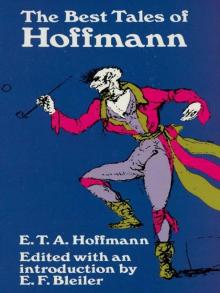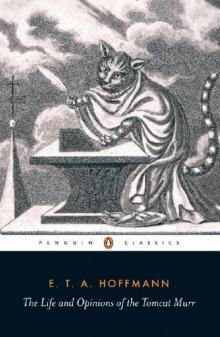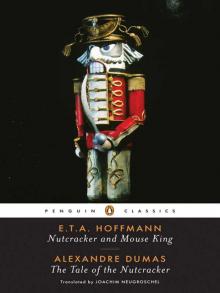- Home
- E. T. A. Hoffmann
Nutcracker and Mouse King and The Tale of the Nutcracker Page 2
Nutcracker and Mouse King and The Tale of the Nutcracker Read online
Page 2
Hoffmann, who also studied law at the university, took a more zigzag course through life and realized that social class differences would keep him apart from Hippel. Moreover, Hoffmann’s demeanor and dedication to art would cause rifts. He began writing novels and musical compositions as a young man and had his first love affair in 1794 with Cora (Dora) Hatt, a woman ten years older and married to a brewery owner. It was this turbulent and passionate affair that caused him to leave Königsberg in 1796. By this time Hoffmann, who had enrolled at the university at sixteen, had passed his first law examinations and was employed by the municipal government at Glogau in Silesia, where he benefited from the connections of another uncle, Johann Ludwig Doerffer. Hoffmann lived in his uncle’s house, and apparently he decided that, to support himself and to pursue an artistic career at the same time, he had to prove himself as a jurist and civil servant and lead a respectable life. Part of his plan to settle down and forget Dora Hatt involved an engagement to his uncle’s daughter Minna. It was clear from the beginning that he was not in love with her and was acting opportunistically to please her father and his own family in Königsberg. When his uncle Johann was promoted, the Doerffers moved from Glogau to Berlin in 1798; Hoffmann accompanied them and continued to work for the Prussian government. During the next two years he reveled in the cultural life of Berlin, attending the theater and opera and visiting museums. In addition he began writing more and more musical compositions and endeavored to have some of his work published or performed, without much success. In the meantime he kept studying for his final law examination, for he knew that, once he passed it, he would receive a permanent position as a civil servant in the Prussian government and would become financially independent. By March 1800 he had passed the exams with honors and was assigned a post in Posen, a small provincial city in Poland, about two hundred miles east of Berlin, that had become part of Prussia. Hoffmann chose this opportunity to spread his wings. Within a short period of time, he not only broke his engagement to Minna but damaged his relations with the entire Doerffer family.
Hoffmann lived a convivial bachelor’s life for a while, enjoying what little cultural life there was in Posen, and he soon married a beautiful Polish woman, Maria Thekla Michaelina Rohrer, whom he called Mischa. She came from a humble middle-class family and was not particularly well educated. But Hoffmann, despite his infatuations with other women, remained devoted to her for the rest of his life. Soon after this marriage, he became involved in a scandal during Carnival season by drawing comical sketches of some of the aristocratic Prussian officers; in consequence he was transferred to the tiny town of Plock (now called Plozk) in the Polish provinces. The only possibility for Hoffmann to survive in Plock was to throw himself into music by studying the great composers and writing his own compositions and essays about music. He even had his first article about music published, in a German magazine, and this publication gave him confidence to continue his study of music with greater dedication. For the most part, he felt himself bored and isolated and applied for jobs in other cities. Thanks to his friend Hippel, who had many important political connections by now, Hoffmann was able to obtain a governmental position in Warsaw, which was under Prussian control.
In 1804, Hoffmann and Mischa moved to Warsaw, where he soon became the center of the musical life in the city. Not only did he compose a singspiel called “The Merry Musicians,” but he also formed a music society and conducted and performed at various concerts. At the same time Mischa gave birth to their daughter, Cäcilia. Hoffmann would have been content to have remained in Warsaw, but Prussia joined the allies in their battles against Napoleon, and the French troops invaded the city. Hoffmann lost his position and, to protect his family, he sent his wife and daughter to Posen to stay with Mischa’s family while he tried to find some way to make a living in Warsaw. However, he failed and soon moved to Berlin, where he hoped Julius Hitzig, another Prussian civil servant, whom he had befriended in Warsaw, might help him. However, despite Hitzig’s family connections—he came from a very wealthy and established Berlin family—there was little Hitzig could do, and by the middle of August 1807, Hoffmann, who was very depressed, was further saddened to learn of the death of two-year-old Cäcilia. At times starving and unemployed, Hoffmann shifted gears, abandoned the civil service, and tried to find a job as a music conductor, though he had very little experience. Fortunately, he was offered a position as director of the music theater in Bamberg, in southern Germany, and by the fall of 1808 he had moved there with Mischa.
No sooner did he make his debut in Bamberg than he lost his job. His lack of experience showed immediately. However, he and Mischa decided to stay in Bamberg, where he made his living by giving music lessons to the children of wealthy families and by writing compositions for the theater. He also started writing short stories, and his first tale, “The Knight Gluck” (“Ritter Gluck”), was published in 1809. The following year the new director of the Bamberg Theater hired him to work as his assistant, dramaturg, and composer. It appeared that conditions in Bamberg might now allow him to flourish as the versatile artist that he was. Indeed, Hoffmann helped stage some of the memorable plays by Calderón, Schiller, Lessing, and Shakespeare and operas by Mozart and Weber. He changed one of his middle names to Amadeus out of admiration for Mozart’s accomplishments and began writing music reviews for various journals as well as short stories about a tormented musical genius by the name of Johannes Kreisler. Everything seemed to be going well for Hoffmann until, in 1811, he fell in love with one of his students, Julia Marc, a thirteen-year-old singer who had a voice like an angel. Hoffmann could not control himself, and though he never had an affair with her, his obsession eventually became public by 1812, causing a scandal in Bamberg. Since it became impossible for him to live and work there anymore, he had to search for a new position. It was during this time that he turned more and more to writing fantasy stories in the midst of composing his opera Undine, based on the fairy tale by his friend Friedrich de la Motte Fouqué.
In 1813, Hoffmann was fortunate to find a position as the conductor for an opera company stationed in Leipzig and Dresden. During the next sixteen months he conducted more than thirty-five operas and singspiels while finishing his own opera, Undine, and collaborating with Fouqué, who wrote the libretto for his opera. In addition, he published two volumes of short stories, Fantasy Pieces (Phantasiestücke, 1814) and wrote his most famous fairy tale, “The Golden Pot” (“Der goldene Topf”). However, the stress caused by the war and disagreements at the opera took their toll, and Hoffmann was dismissed as conductor by the director of the company, Joseph Seconda. The loss of a secure income caused great difficulty for Hoffmann and Mischa. By chance, however, his friend Hippel appeared in Leipzig and encouraged him to resume his career in the civil service. Indeed, once again Hippel came to his rescue and procured a position for Hoffmann at the justice ministry in Berlin.
In September 1814, Hoffmann arrived in Berlin, and much to his surprise, he was greeted as a minor celebrity. His fantasy stories and fairy tales had been extremely well received by literary circles throughout Germany, and for the next eight years until his death in 1822, Hoffmann’s stories were very much in demand by the publishers of ladies’ magazines, which had become very popular by that time. In addition to these publications, he wrote two intriguing novels, The Devil’s Elixirs (Die Elixiere des Teufels, 1815–16) and The Life and Opinions of the Tomcat Murr (Die Lebensansichten des Katers Murr, 1819–21); published “Nutcracker and Mouse King” and “The Strange Child” (“Das fremde Kind”) in two volumes of Children’s Fairy Tales (Kinder-Märchen, 1816–17), which included stories by Fouqué and Carl Wilhelm Salice Contessa; and collected his fairy tales, novellas, and fantasy stories in two volumes with the title Night Pieces (Nachtstücke, 1815–17) and in four volumes with the title The Serapion Brothers (Die Serapionsbrüder, 1819–22).
No sooner did he settle down in Berlin than he began to hold weekly meetings at a nearby tavern with some of the
leading writers and artists of the day; they would gather together, discuss cultural and political events, drink and eat—and they would conceive projects together. Among the writers who would appear on a regular or irregular basis were Fouqué, Contessa, Adelbert von Chamisso, Ludwig Tieck, Clemens Brentano, and David Ferdinand Koreff, as well as the famous actor Ludwig Devrient and Hoffmann’s friend Hitzig, who worked at the same ministry that he did. As time went on, the gatherings became less frequent, until Hoffmann called a formal meeting of many of the “members” of the group on November 14, 1818, the saint’s day of the holy Serapion, to renew their association and discussions. The friends and writers of this group were depicted fictitiously in the framework of The Serapion Brothers, but there is no clear identification of one particular character with a real person. Actually it was Hoffmann who played all the roles in this framework collection, a multidimensional discourse about the imagination, fantasy works, music, and devotion to art. The manner in which he conceived this book basically shows how Hoffmann was inspired by his friends just as he was inspired by the plays, concerts, and operas he attended in Berlin. When his own opera, Undine, had finally been performed in 1816, he became even more famous and was constantly invited as an honored guest to attend literary salons and other cultural events.
But it would be wrong to focus on Hoffmann solely as an accomplished artist who became a gallant man-about-town. Hoffmann was a disciplined writer, constantly creating new types of tales and novels. His production and dedication to his writing damaged his health, and he was often sick. Moreover, there was always stress at the justice ministry. He began as a minor civil servant and was eventually promoted to the rank of councilor and judge. Along with promotions came merit increases in his salary because of his scrupulous work. However, his scruples also landed him in trouble. By 1818, Prussia, Russia, Austria, and England had formed the Holy Alliance, and there was a conservative and repressive political movement in all these countries that triggered protests by liberal groups, especially students. The leaders of the German principalities issued decrees that called for the punishment of anyone suspected of subversive activities. Because of Hoffmann’s reputation as a fair and ethical judge, he was appointed to a special commission (the Prussian Intelligence Committee against High Treason) to investigate subversive activities (somewhat like the House Committee on Un-American Activities during the 1940s and 1950s). In many cases, Hoffmann brought about the release of people with liberal ideas who had been falsely charged with illegal activities. Hoffmann consistently defended the civil rights of the accused. The most important case involved the famous Friedrich Ludwig Jahn, founder of gymnastics, who had been in prison for eight months. Karl Albert von Kamptz, the notorious commissioner of police in the Department of Interior, who belonged to the Ministerial Commission, had Jahn sent to the fortress of Kolberg, announcing that Jahn had been proven guilty, something that was untrue. Hoffmann wanted Kamptz brought before the courts but was prevented from doing so by the King of Prussia himself. Hoffmann served on this committee for two years (1819–21), and in 1822 he satirized Kamptz as Knarrpaxiti in one of his last stories, “Master Flea” (“Meister Floh”), and then boasted about it. Once Kamptz knew about this, he prevented the publication of the story in Frankfurt and pressed charges against Hoffmann, who by this time was dying from a liver disease. Hoffmann was ordered to attend the court proceedings, but he had become so ill he could not leave his bed. Once again his friend Hippel intervened, and Hoffmann was allowed to prepare a masterful defense of his case, and the king let him off with a reprimand. Soon after, “Master Flea” was published with certain portions omitted. It was Hoffmann’s last laugh at the corrupt bureaucracy that he had so loyally served. By now he had atrophy of the liver and degeneration of the spinal marrow. He was in great pain, but kept writing until his throat became paralyzed. He died on June 25, 1822, at the age of forty-six, and was buried in Berlin. His wife, Mischa, left Berlin and went to Posen, where she stayed until 1835; though looked after by Hoffmann’s loyal friend Hitzig, she died in poverty in the small city of Warmbrunn on January 27, 1859.
Hoffmann was a late bloomer as a writer, but once he discovered his extraordinary talent, he become almost obsessed by his writing and demanded total dedication of himself to his craft, something he often demanded of the protagonists in his stories, who often collapsed or died because they could not maintain their dedication or find a way to balance the dedication to art with the crass demands of their mundane existence. This was the major conflict in many of Hoffmann’s stories, life in the paradise of art versus life in the humdrum world of the philistines. It was clearly expressed in his first major fairy tale, “The Golden Pot,” which is subtitled “A Fairy Tale from the New Time,” a signal that Hoffmann was about to use the fairy tale in an unusual modern way to address readers with a new sensibility. To a certain degree, Hoffmann carried the Romantic experiments of Wilhelm Heinrich Wackenroder, Ludwig Tieck, and Novalis to its logical end with his intricate tales of magical realism. Not only is “The Golden Pot” the culmination of the innovative fairy tales produced by the Romantic writers, it is also the pioneer work of European magic realism. Hoffmann developed an uncanny narrative style of reportage and often began his tales as though he were writing an article for a newspaper or preparing a dry historical chronicle. However, after a few paragraphs he conflates reality with fantasy, and the boundaries between the two collapse. Both reader and protagonist must find their way through a labyrinth of events, and in the course of the narrative, they must also learn to position themselves to see anew, to perceive their world anew, and to delight in their imaginations.
This is the ultimate message of “Nutcracker and Mouse King,” but there is more to this story and its background than meets the eye. Hoffmann wrote this fairy tale in 1816 ostensibly for the children of Julius Hitzig, but in reality it was a tale about the Hitzig family and their social class and how children were being raised. Though Hoffmann himself led an eminently bourgeois life, he was personally unconventional and somewhat eccentric, while Hitzig was serious and proper and felt that there was something immoral about Hoffmann’s lifestyle. In Hitzig’s eyes, Hoffmann was somewhat weird. Nevertheless, they were good friends, and Hitzig attended Hoffmann’s weekly Serapion meetings while Hoffmann was a welcome guest in the Hitzig house. By 1816, the Hitzigs had two children, Marie and Fritz, ages six and eight, and Hoffmann had great affection for them, although he was known never to caress the children or physically demonstrate his feelings. Rather, he showed his affection through gifts and stories. In 1815, he had given the Hitzig children an illuminated castle that he himself had built, and he told them the story of “Undine” and other tales. Hoffmann was an energetic, small, wiry man with a twinkle in his eyes that often blitzed like lightning. He was not particularly handsome, but when he began speaking and played music, he could be captivating. There was magic about Hoffmann that drew all kinds of people to him, and there is no doubt that the figure of Drosselmeier in “Nutcracker and Mouse King” bears some of his characteristics, just as the children are related to a certain degree to Marie and Fritz Hitzig. But it would be misleading to interpret “Nutcracker and Mouse King” from a simple autobiographical perspective. After all, his tale was a radical fairy tale intended, like “The Golden Pot,” to give a new form to fairy tales written for children, and indeed, Hoffman was preparing the way for many writers of modern fairy tales like Hans Christian Andersen, who owed Hoffmann a great debt.
Hoffmann was not all that conversant with children’s literature at the beginning of the nineteenth century, but he knew from his own experience and from observing the children of proper and decent bourgeois families that their lives were overly regulated, and in keeping with the rationalism of the times, they were “drilled” to behave according to moral and ethical principles that were to curb their imaginations. Though Hoffmann himself had never been able to abandon these principles altogether and though he felt at home in, and needed the security o
f, a settled middle-class life, he had always felt confined by all the conventions and constantly sought alternatives to them in his tales, if not in his own life. He could be abrasive and also gentle in his ironical critique of the neat and homey bourgeois customs. But he never abandoned championing the imagination with all his critical powers.
In 1816, when he proposed to Fouqué and Contessa that they collaborate on a book of fairy tales for children, he knew that his own contribution would be a kind of manifesto about a new form of fairy tale. He had already announced his “radical” intentions in “The Golden Pot,” a complex fairy tale for adults, and he wanted to do the same with “Nutcracker and Mouse King” and “The Strange Child” for children. This became much clearer when he reprinted “Nutcracker and Mouse King” and “The Strange Child” in The Serapion Brothers in 1819, framed by a discussion about the merits of the imagination and irony and about what makes an appropriate fairy tale for children. Hoffmann indicates that his fairy tales are for children with lively imaginations and also for adults. Indeed, both his tales incorporate what he called the guiding Serapion principle, which was to determine the value of all the stories told by the friends in The Serapion Brothers:
Each one of us is to test whether he really has seen what he seeks to communicate before he dares to say it aloud. At the very least, each one of us is to seek as earnestly as possible to capture the exact image, which arises within him, with all its shapes, colors, lights, and shadows, and then, when he feels himself ignited by all of this, to transmit this portrayal to the outside world.

_preview.jpg) Weird Tales. Vol. I (of 2)
Weird Tales. Vol. I (of 2)_preview.jpg) Weird Tales, Vol. II (of 2)
Weird Tales, Vol. II (of 2) The Best Tales of Hoffmann
The Best Tales of Hoffmann The Life and Opinions of the Tomcat Murr
The Life and Opinions of the Tomcat Murr Nutcracker and Mouse King and The Tale of the Nutcracker
Nutcracker and Mouse King and The Tale of the Nutcracker The Sandman
The Sandman